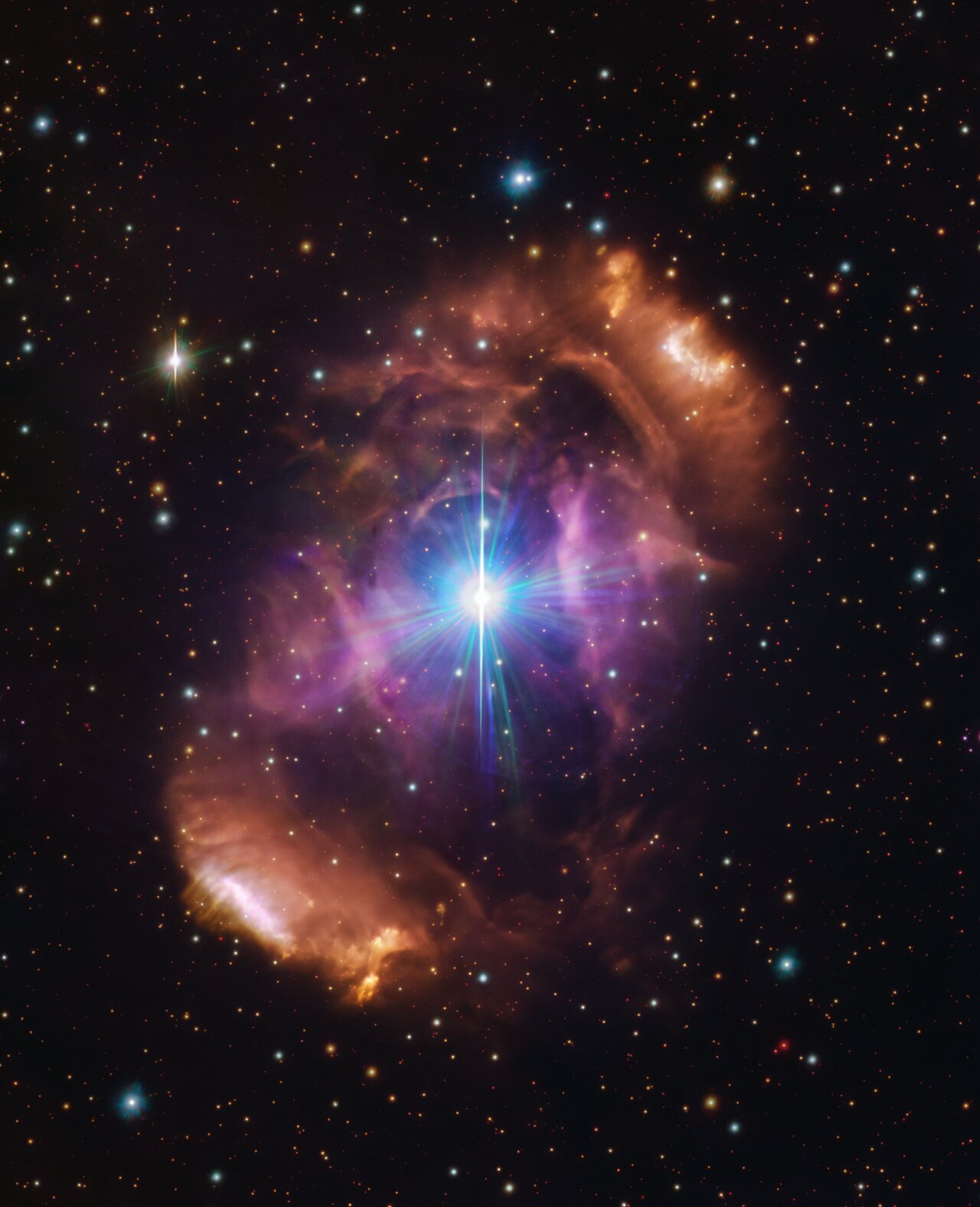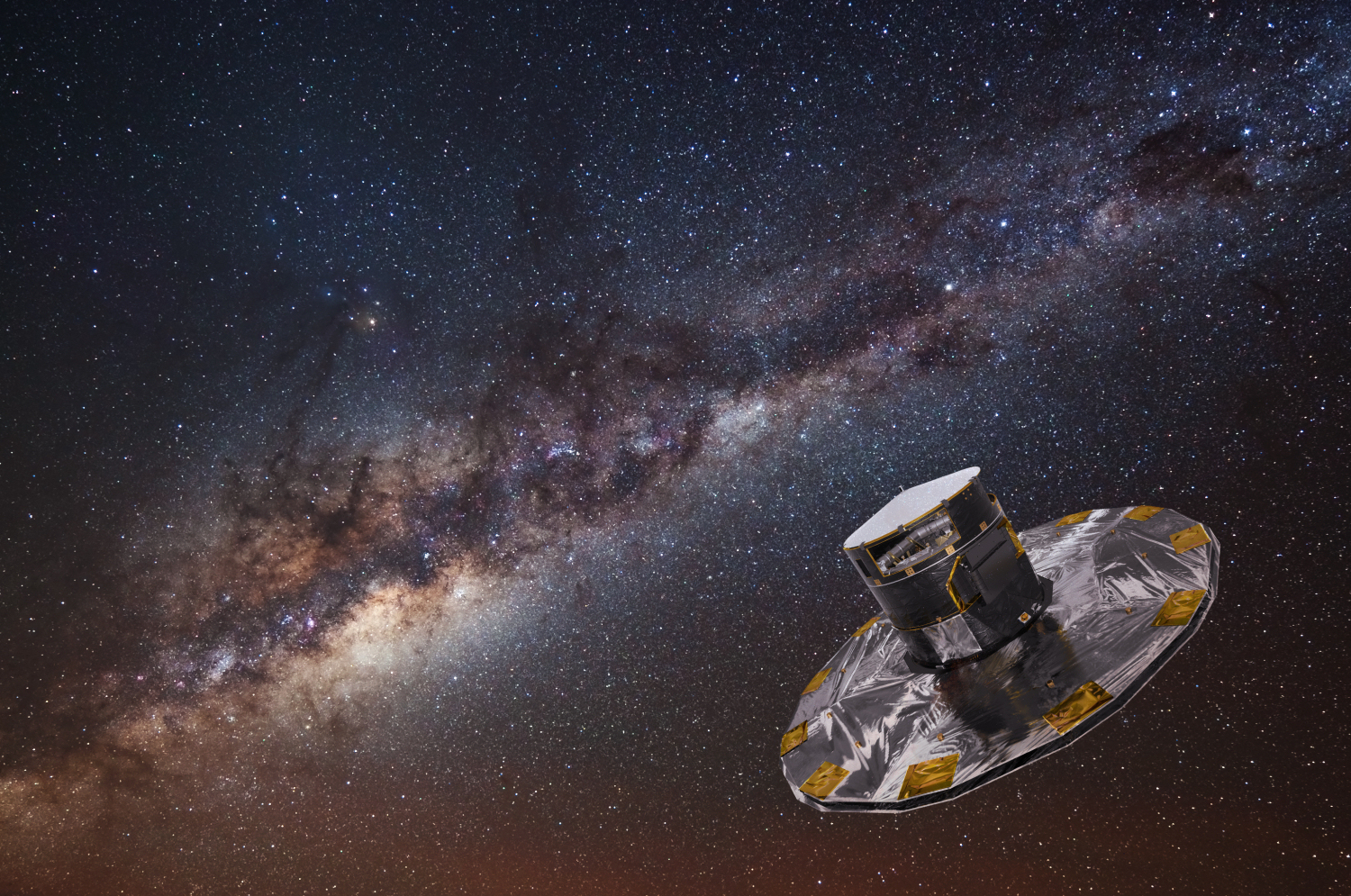Press Releases
16/04/2024
New Black Hole discovered with ESA’s Gaia satellite

Today the European Space Agency (ESA) and the Gaia collaboration teams reveal the discovery of a high-mass stellar black hole of 33 times our Sun’s mass in the Milky Way. The Royal Observatory of Belgium contributed to this discovery thanks to the radial velocity data it helped to process.
Third black hole discovered with Gaia data
A stellar black hole results from the sudden collapse and subsequent supernova explosion of a heavy star at the very end of its short life, after consuming all its fuel. Gaia observed the new black hole in a system of two stars bound together by gravity (called a binary star) in the inner halo of the Milky Way, a spherical cloud of evolved stars surrounding its centre. It is the third stellar black hole discovered by Gaia. The first two are also part of binary star systems.
The Gaia data reveal this new black hole is composed of a giant companion star and a stellar black hole of about 33 times the solar mass. Because it is the third black hole identified with Gaia data, this particular binary was baptised Gaia BH3.
Lees de volledige persmededeling <klik hier>
Read the full press release <click here>
Lisez le communiqué de presse <appuyez ici>
11/04/2024
Violent star history: beautiful nebula and magnetic star born from a stellar clash
When astronomers looked at a stellar pair at the heart of a stunning cloud of gas and dust, they were in for a surprise. Star pairs are typically very similar, like twins, but in HD 148937, one star appears younger and, unlike the other, is magnetic. In a newly published Science research paper, scientists, including Laurent Mahy from the Royal Observatory of Belgium, suggest there were originally three stars in the system, until two of them clashed and merged. This violent event created the surrounding cloud and forever altered the system’s fate.
A Very Special Star System
‘When doing background reading, I was struck by how special this system seemed,’ says Abigail Frost, an astronomer at ESO in Chile and lead author of the study published today in Science. The system, HD 148937, is located about 3800 light years away from Earth in the direction of the Norma constellation. It is made up of two stars much more massive than the Sun and surrounded by a beautiful nebula, a cloud of gas and dust. ‘A nebula surrounding two massive stars is a rarity, and it really made us feel like something cool had to have happened in this system. When looking at the data, the coolness only increased.’
A blue bright star in space with an orange nebula cloud.
Lees de volledige persmededeling <klik hier>
Read the full press release <click here>
Lisez le communiqué de presse <appuyez ici>

04/01/2024
Two of our scientists honoured by the Royal Academy of Belgium
On Saturday 16 December 2023, the Royal Academy of Science, Letters and Fine Arts of Belgium awarded two of its prizes to Dr Orkun Temel and Dr Thibault Merle, two scientists working at the Royal Observatory of Belgium.
Orkun Temel, under FWO contract, has won the 2023 annual Academy Competition – Group II – Astronomy-Physics by answering their request for ‘an original contribution, experimental or theoretical, on exoplanets and their habitability.
Thibault Merle, under FED-tWIN contract, has been awarded the 2023 Paul and Marie Stroobant Prize for his discovery, published in the journal Nature Astronomy in 2022, of a quadruple star system whose future evolution could give rise to a supernova.
Lees de volledige persmededeling <klik hier>
Read the full press release <click here>
Lisez le communiqué de presse <appuyez ici>
10/10/2023
Building the most detailed 3D map of the Milky Way: Belgian astronomers contribute to the Gaia Focused Product Releases
Today the European Space Agency (ESA) and the Gaia collaboration teams are publishing new data in the form of five Focused Product Releases. The results are very promising, making of this delivery a first teaser of what will be the fourth version of the Gaia catalogue (Gaia DR4), expected by the end of 2025.
De Gaia-satelliet brengt sinds 2014 de hemel in kaart met daarop sterren die een miljoen keer zwakker zijn dan zichtbaar met het blote oog. De derde versie van deze meest volledige en gedetailleerde sterrencatalogus (Gaia DR3), die in juni 2022 werd gepubliceerd, vormt een mijlpaal voor astrofysisch onderzoek. Gaia’s uitzonderlijk nauwkeurige afstanden, beweging in de ruimte, en fundamentele parameters van sterren, evenals de classificatie van quasars en de nauwkeurige astrometrie van asteroïden maken nu deel uit van het dagelijkse werk en wetenschappelijk onderzoek van de meeste astronomen.
Lees de volledige persmededeling <klik hier>
Read the full press release <click here>
Lisez le communiqué de presse <appuyez ici>

21/08/2023
James Webb Space Telescope - Imaging of the "Ring Nebula" in Lyra
Dr. Griet Van de Steene and Dr. Peter van Hoof, both working at the A&A department at ROB, are part of the "ESSENcE" team (Evolved StarS and their Nebulae in the JWST Era). This is an international group of experts studying planetary nebulae and related objects. They obtained JWST observations to study this famous planetary nebula in Lyra.
The Ring Nebula is an ideal target to unravel some of the mysteries of planetary nebulae. It is nearby, approximately 2,200 light-years away, and bright – visible with binoculars on a clear summer evening from the northern hemisphere and much of the southern. It displays intricate structures of the final stages of a dying star, a phase of a Sun-like star’s stellar lifecycle.
The ESSENcE team realized that Webb observations would provide them with invaluable insights, since the Ring Nebula fits nicely in the field of view of Webb’s NIRCam (Near-Infrared Camera) and MIRI (Mid-Infrared Instrument) instruments, allowing it to be studied in unprecedented spatial detail.
the official Press Release on the NASA blog
the official Press Release from ESA
Webb is the largest, most powerful telescope ever launched into space.
Webb is an international partnership between NASA, ESA and the Canadian Space Agency (CSA).
04/08/2023 - JWST NIRCAM images of the Ring Nebula
James Webb Space Telescope Captures Stunning Images of the "Ring Nebula" in Lyra
The James Webb Space Telescope (JWST) has recorded breath-taking new images of the iconic Ring Nebula (Messier 57). The images, released today by an international team of astronomers led by Prof. Mike Barlow (UCL, UK) and Dr. Nick Cox (ACRI-ST, France), showcase the nebula's intricate and ethereal beauty in unprecedented detail, providing scientists and the public with a mesmerizing view of this celestial wonder.
For many sky enthusiasts, the Ring Nebula is a well-known object that is visible all summer long and that is located in the constellation Lyra. A small telescope will already reveal the characteristic donut-like structure of glowing gas that gave the Ring Nebula its name. It is a planetary nebula, objects that are the colourful remnants of dying stars that have thrown out much of their mass at the end of their lives. The Ring Nebula’s distinctive structure and its vibrant colors have long captivated the human imagination. The stunning visuals captured by the JWST offer an unparalleled opportunity to study and understand the complex processes that shaped this cosmic masterpiece.
Read the full press release <click here>